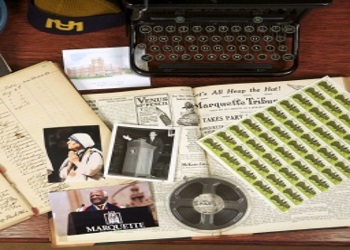Incunabula
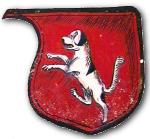 |
Saint Augustine, Bishop of HippoDe Civitate Dei |
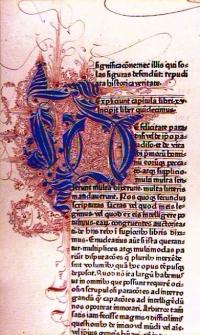 An example of the intricate illumination work found within De Civitate Dei. |
De Civitate Dei Marquette University Libraries preserves a small collection of incunabula, books from "the cradle period" (1450-1501) of Western printing. Of particular note is De Civitate Dei (The City of God). This rare second edition printed in Latin is from the presses of Johannes Fust and Peter Schoeffer, Gutenberg's successors in Mainz. The type faces are the same used to print his 1462 Bible. The opening to each book is extensively rubricated in red and blue, while book numbers and illuminated capitals appear on each page. It is believed that 500 copies of the book were printed, but it is not known how many copies still exist today. Elaborate hand-drawn illustrations distinguish Marquette's copy from others known to exist. An unsigned, nineteenth-century note on the final leaf attributes the rubrication to Lazarus von Andlau. The author of the note states he has seen a book signed by Lazarus with similar rubrication in the shop of the bookseller Heberle in Cologne. This edition includes commentary by the Oxford Dominicans Nicholas Trevet (1297-1334) and Thomas Waleys (d. 1349), printed separately from the text. Each book is preceded by a chapter table. The City of God was written by St. Augustine (354-430) in the fifth century as a defense of the Catholic faith and is considered one of the most significant pieces of Christian literature ever created. A 1999 gift from Rose Mary (Sullivan) and Frank Matusinec, De Civitate Dei was the commemorative one millionth acquisition to Marquette Libraries. Former Milwaukee public school teachers and Marquette alums, Mr. and Mrs. Matusinec donated the funds to underwrite purchase of the book from the Whitefish Bay Public Library. Mrs. Sidney C. Fraser had donated the volume to the public library in 1957, in memory of her husband, a former member of the library's board of trustees. The volume had once been part of the Bibliothecae Weisenaviensis, a monastic library in the village of Wurtenbourg, Germany. The detail depicted above is an unidentified family crest of a former owner of this volume. |
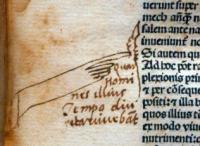 |
Nicholas of LyraThe Old Testament |
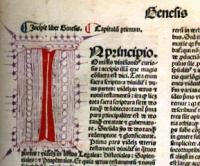 Details taken from Nicholas of Lyra's Old Testament Commentary 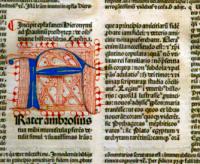 |
The earliest edition of the Bible preserved by the Department of Special Collections is a 1482 two-volume edition of the Old Testament. Printed by Renner of Heilbrunn, in Venice, the Old Testament is printed in Latin within a central text block, with Nicholas de Lyra's (ca. 1270-1349) explanations surrounding the main text. It is the first printed explanation of the Bible. Illuminated capitals - in red, blue, and violet - denote the beginning of paragraphs throughout both Old Testament and de Lyra's text. Both volumes are in fair condition, having been rebound in 1939. The title page is missing, but the text has been copied on the front end leaf as: Biblia Sacra Latina (Sacred Bible in Latin). The original plain wooden boards are worm-eaten and show evidence of having been chained to a press. The provenance of these volumes has not been investigated, although priests from the Society of Jesus at Marquette have owned the volumes since at least the late 19th century. Above is a detail of a margin note added by one of the volume's early owners. |

